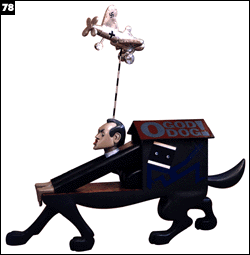
Painted wood, steel, resin, enamel, glass and avion
philippin.
H.157, W.163, D.38 cm (1996).

(Mertz Construction), 1921
assemblage
36,7 x 21,5 cm
Philadelphia Museum of Art
(A.E.Gallatin Collection)
Click for a larger view

Man Ray (see sculpture 54)
photographied Kurt Schwitters working on his Ursonate.
You can listen to the scherzo recorded
by the author on May 5, 1932 for the Sźddeutschen Rundfunk.
You can also see
the spectrum of his voice while reciting the beginning of his scherzo.
|
|
n order to present Kurt Schwitters, one of the great minds of the century,
who was born in Hanover in 1887 and died in England very poor in 1948,
it is best to borrow three quotations from the text Harald Szeeman dedicated
to him in the catalogue of the 1994 Pompidou Center show.
From Kurt Schwitters : "A game with serious problems. That is art".
"We play until death comes and gets us."
From Hans Richter : "And that's how he pasted, nailed, wrote poems,
made typographical compositions, sold, printed, composed, did collages,
recited, whistled, barked and loved, bellowing, never minding anybody,
the public, a given technique, established art and himself. He did all
and most times all at the same time. His guideline was less the total
art work according to Ball or Kandisnky, the temporal combination of all
the arts, than the idea of continuously blurring the limits and integrating
the arts within one another, including the machine in art as an "abstraction
of the human mind", kitsch, chair legs, singing and whispering.
In reality, HE was the total art work: Kurt Schwitters."
DADA's strongest personality, he created MERZ. One of his most outstanding
works was his mere presence in 1933 at a dinner given by the German Press
Union for the Futurist Marinetti. Again in the catalogue of the Pompidou
center, we find an extraordinary account of that banquet by Lucia Moholy-Nagy
who attended it along with her husband and Schwitters. Attending were
Hitler*, a great admirer of Mussolini's, Göring, Hess**, Goebbels,
Gerhart Hauptmann and Robert Ley, patron of the Nazi organization "Kraft
durch Freude" (Power through Joy) - who committed suicide during the
Nuremberg trial. Sitting next to Schwitters, Ley had to listen in amazement
to his beautiful ravings. It may be regretted that there are neither recordings
nor pictures of the end of the banquet, when Marinetti bellowing his poem
"Der Überfall auf Andrianopel" started pulling the tablecoth
and tipped wine and dirty dishes on Hitler's lap.
Kurt Schwitters soon exiles himself in Norway then, with the German arrival,
runs away to England where he lands on June 19, 1940. He is interned in
Camp Hutchinson, on the Isle of Man, along with two thousand German nationals,
most of which are anti-nazi intellectuals. The camp becomes, according
to the writer Fred Uhlman, one of the best universities in Europe. He
writes in his book "The making of an English man" that Schwitters
had himself built a dog kennel just big enough for him to sleep in and
that from time to time he would come out of it barking with the sound
of a dachshund. He kept up with his work as an artist, nailing wood, or
painting on linoleum. He also produced porridge sculptures, which gave
off a sickening smell.
He is seen here barking outside his dog kennel with a German plane, just
come from bombing Liverpool, flying overhead.
*see sculpture 33
**see sculpture 63
|
